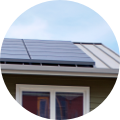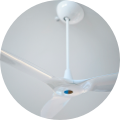Biophilic Design
from the Start
From our first design concept, we knew we wanted the home to feel special: not whiz-bang next generation technological, but rather naturally relaxing and comfortable. We created a large open space of light and air, not because it is the most efficient way to light the home, but because it just feels right. We also added automatic shades with easy manual overrides for the times when darkness or privacy are preferred.


Automatic Controls
plus Switches
Smart controls can increase the efficiency and overall comfort of the system, so we programmed our controls to respond to motion and then select one of five lighting scenes base on the time of day. That way you get nice, bright lights while making dinner, and a softer light when getting a drink later in the evening. We also included override switches in every room in case the automatic scene wasn't quite perfect.

2700K above, warm amber below
Your body's natural 24h ("Circadian") cycles can be disrupted by bluish light in the evening. We used 2700K fixtures for the main lights, plus very warm amber footlights for safety in the middle of the night. We also experimented with an adjustable-color up-light, but ultimately replaced it with a fixed color temperature.
 Day
Night
Day
Night

Consideration for
your neighbors
As tempting as it may seem to point landscape lights upwards into your trees, or to have a giant searchlight turn on at the slightest motion, these choices have direct impact on our dark skies and our neighbors' light trespass and circadian health. Using downward-facing amber lights is a simple act of consideration for others' health and their enjoyment of the outdoors.
Control comes
at a price
The scenes worked nicely, but the controller circa 2013 had significant power consumption and was complicated to adjust. As shown in this chart, the sum of all of our home's control systems (including lighting) consumed more energy than the lights themselves. The good news is that lighting controls continue to improve, and should be a part of any modern lighting plan.

Technical Resources
The Smart Home project was about generating insights for others to build upon. As you develop your next home, please use any of our specs, drawings and data to help create a more sustainable future.

Architectural Plans and Controls Wiring
If you like our design, feel free to start with these plans to build something great.

Interior Design Plans and Specifications
View our original layouts, as well as the Excel file of furnishing and lighting specs.









